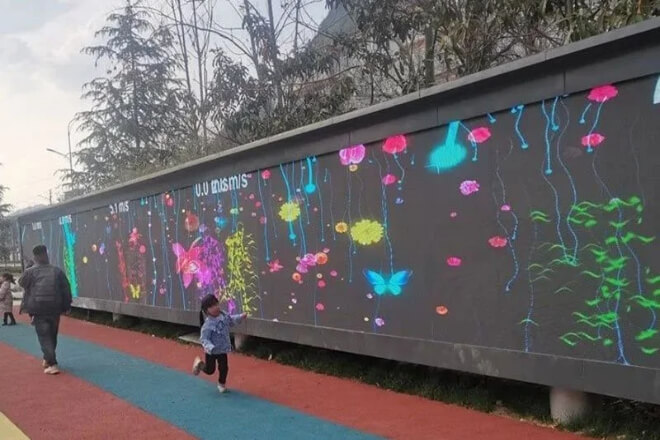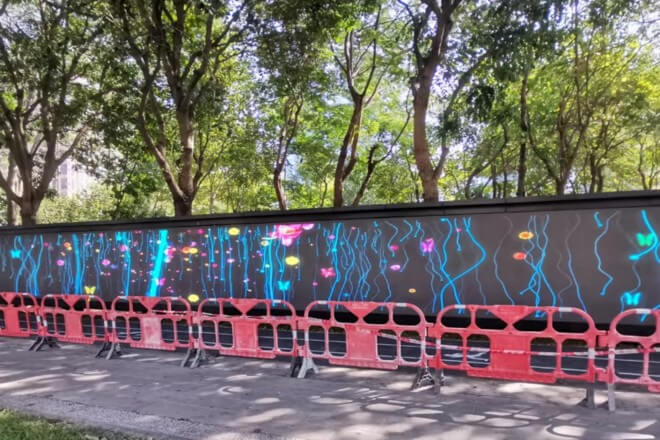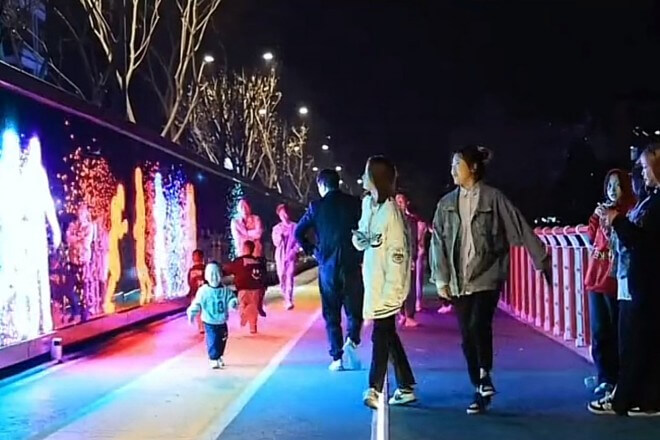Introducción
The interactive LED display screen on the trail has become an important part of the urban landscape and information dissemination.
But do you know? Installing these high-tech devices is not an easy task, and there are many details and challenges hidden behind it.
Do you want to know what you need to pay attention to when installing the interactive LED display screen on the trail? This article will reveal it to you one by one.
Tabla de contenido
Note 1: Environmental assessment and investigation of the trail before installation

Before installing the interactive LED display screen on the trail, you must first take a good look at the trail.
First of all, you have to see how many people usually walk here, when there are the most people, and when there are the least people.
You also have to think about everyone’s walking habits, whether they all walk in one direction or back and forth, and whether they walk in a hurry or stroll slowly.
After all these are figured out, you can decide how big the display screen should be, where to put it, how to design the interactive function, and how to adjust the angle so that people coming and going can see and use it.
Next, you have to see what the terrain of the trail is like, whether it is flat or has slopes and bumps, and whether there are steps or something.
These terrain conditions will affect how the LED display screen is installed and whether it can stand firmly.
If you encounter a sloped trail, you have to calculate the angle of inclination of the display screen. Otherwise, the picture will look awkward, and the equipment will easily have problems.
There are also climatic conditions that cannot be ignored. See if it rains and snows frequently or if the sun is strong and the humidity is high.
According to these climatic characteristics, you have to choose the appropriate protection level and material for the LED display screen. Otherwise, the display screen will be easily “cleaned up” by bad weather.
For example, in places with heavy rain, the waterproof performance of the display screen must be strong enough, and the protection level must reach at least IP65 so that it will not be “damaged” by rain.
In places with high temperatures, the display screen must have good heat dissipation so that it can normally work in hot weather and will not “get a heat stroke.”
Finally, the surrounding fuente de alimentación and network conditions must also be understood.
See if there is a ready-made power supply nearby, whether the power supply is stable, and whether it can meet the power demand of the display screen.
If there is no suitable power supply around, you may have to consider pulling a wire or using solar panels to power it.
There is also the network. Now this interactive LED display screen, many functions can only be realized by connecting to the Internet, such as updating content and interacting with people.
So, you have to see if the nearby network signal is good and whether the bandwidth is sufficient.
If the network is not good, you have to find a way to enhance the signal or use a wired network to ensure that the display screen can access the Internet stably so that the function of the display screen can be fully utilized.
Note 2: Choose the right type and specification of the LED display screen

Choosing the right type and specification of the LED display screen is a key step to making the display screen play a big role in the trial.
First, you have to think about the interactive function requirements. If you want the display screen to be touch-sensitive, you have to choose one that supports touch function.
If you want to trigger the interaction by footstep pressure, you have to use a pressure-sensitive display screen. If you want to operate remotely, an infrared-sensitive display screen will come in handy.
In short, you have to choose the appropriate sensing method according to the actual purpose of the trial and the interactive effect you want to achieve.
Then, the size, resolución, y tamaño de píxel of the LED display are also very important.
You have to look at the size of the trail. If the place is spacious and the flow of people is large, the size of the display must be larger so that people far away can see clearly.
The resolution cannot be low either; at least the picture must be clear and not blurry. The pixel pitch must also be determined according to the size of the display and the viewing distance.
If the pitch is too wide, the picture will be grainy, and if it is too narrow, the cost will go up, so a suitable balance must be found.
For example, P2.5, P3.91, or P5 outdoor LED displays can be seen clearly.
Moreover, the trail interactive screen is an LED display screen that is viewed at a close distance, so it is best to use a small-pitch LED display screen with a resolution of 3840hz.
Finally, the protection level cannot be sloppy. On outdoor trails, the display must be able to withstand wind and rain, so a waterproof function is a must.
It must also be dustproof; otherwise, the picture will be dim if there is too much dust. If there are people coming and going on the trail.
The chance of accidentally touching the display is also high. Be sure to choose one with IP65 protection level.
Therefore, the anti-collision performance cannot be less so as to ensure that the display can work normally on the trail for a long time, bringing everyone a good and beautiful interactive experience.
Note 3: LED display installation structure design and safety assurance

In the process of installing LED displays, installation structure design and safety assurance are extremely critical links and must not be sloppy.
First, we must focus on the stability of the fixed bracket and base. To put it bluntly, this display is a “big guy.”
If the bracket and base are not strong, once it encounters strong winds or external force collisions, it will easily shake or even fall directly.
Once it falls, it will not only damage the LED display but also may injure passers-by, which will be a big trouble.
Therefore, the materials of the bracket and base must be selected with high quality, and the installation must be strictly in accordance with the specifications to ensure that it can stand there steadily, like a solid fortress; no matter how windy and rainy it is, it can’t move.
Secondly, the height and angle of the installation must also be carefully considered. This is not just a place to install it, and it must conform to the principles of ergonomics.
In short, it must be convenient and easy to use. If it is installed too high, people will have to crane their necks to see it, which will not only make their necks sore after a long time but also make it awkward to interact.
If it is too low, it will be easily blocked by the crowd, affecting the viewing effect. Generally speaking, the center position of the display screen should be about the same as the eye level of most people so that everyone can operate it smoothly.
The angle must also be appropriate, and it must be adjusted according to the direction of the trail and the surrounding environment. Direct sunlight or reflections cannot affect the viewing effect.
If the angle is not appropriate, the picture will look blurry, which greatly reduces the practicality and attractiveness of the display screen.
Finally, cable wiring is also a detail that cannot be ignored. If the cables are dragged on the ground in a mess, it will be too dangerous.
Pedestrians can easily trip if they are not careful, especially those with children or the elderly, who are more likely to have accidents.
Moreover, exposed cables are easily damaged. Once the cables are damaged, not only will the display screen not work properly, but it may also cause safety hazards such as leakage.
Therefore, it is best to use hidden cables and hide the cables in the wall or underground pipes.
If it is really impossible to run hidden wires, you have to use cable troughs or wire tubes to protect the cables, which is safe, beautiful, and can extend the service life of the cables.
In short, these details must be taken into consideration to ensure that the LED display is installed firmly and safely so that everyone can use it with confidence.
Note 4: Safety and stability of the power and network interfaces of the interactive LED display on the trail

When installing the interactive LED display on the trail, you must pay attention to the safety and stability of the power and network interfaces. Otherwise, the display may “get angry,” and the user experience will be greatly reduced.
First of all, you must ensure that the power supply is stable. LED display screens are very sensitive to voltage.
If the voltage fluctuates, the picture may flash constantly, the color will become strange, and in serious cases, it will “strike” directly.
Therefore, a voltage-stabilizing power supply device is a must. It can control the input voltage steadily like a “voltage housekeeper.”
In addition, outdoor LED display screens must be lightning-proof. Otherwise, the display screen may be “struck” by lightning when a thunderstorm comes.
Installing a lightning protection device is like putting on a “lightning protection armor” for the display screen, which can effectively block the attack of lightning and allow it to safely pass the thunderstorm.
Secondly, the network connection must be powerful. Now this interactive display screen, many functions have to rely on the network to realize, such as updating content, interacting with users, etc.
If the network is stuck, the user clicks something for a long time without a response; how annoying.
Therefore, whether it is a wired or wireless network, it is necessary to ensure that the network speed is fast and the signal is stable so that users can operate the display screen smoothly without being stuck.
Moreover, a stable network can also facilitate remote management and updating of content without having to run to the site every time to operate, saving worry and effort.
Finally, the emergency power-off protection device is indispensable.
In case of an emergency, such as a power grid failure or a fire, this device can immediately cut off the power supply to prevent the display screen from being damaged due to a sudden power outage and also avoid greater problems caused by equipment failure.
This is like equipping the display screen with a “safety guard” to protect the safety of the display screen and users at critical moments.
In short, only when these details are in place can the display screen run safely and stably, allowing users to use it happily and at ease.
5. Conclusión
Through the above content, we have a comprehensive understanding of the precautions for installing the interactive LED display screen on the trail.
Although these details are small, they are related to the service life and user experience of the display screen. I hope this article can provide a practical reference for relevant practitioners.
Finalmente, si quieres saber más sobre las pantallas LED, por favor contáctenos.
